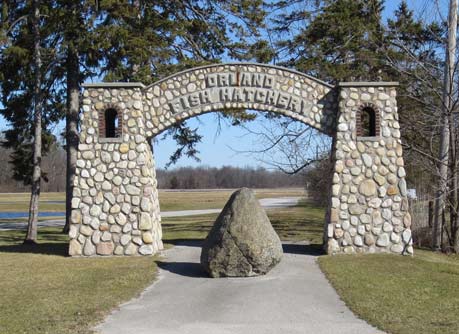- Fawn River State Fish Hatchery Alerts
- None at this time.

6889 N. SR 327
Orland, IN 46776
260-829-6241
Hours: 8 am - 4:30 pm, M-F.
on.IN.gov/fawnriver-sfh
Get Directions
Fawn River Fish Hatchery is located one mile north of the town of Orland on S.R. 327. The office is open from 7:30 a.m. to 3:30 p.m., Monday through Friday. The District 2 Fish Management Biologist’s office is also located at Fawn River State Fish Hatchery. The property grounds are open to the public from sunrise to sunset, seven days a week.
- Fish Production Facilities
In 1933, the Orland Conservation Club constructed a fish rearing pond in an old mill race north of town. Later, this modest fish rearing facility was to become one of Indiana’s larger fish hatcheries.
On April 25, 1935, the Orland town board purchased a tract of land adjacent to the mill race. Part of the land was to be used for the construction of a fish hatchery and the balance for a park and recreation area. Labor and part of the funds for improving the property were obtained from the FERA, a federal relief agency. The remaining funds were obtained from the town coffers. The hatchery, completed in 1937, was called the Orland Fish Hatchery and consisted of four earthen ponds ranging in size from 2.07 to 3.37 acres. The town treasury was reimbursed by the Department of Conservation (now called the Department of Natural Resources) for fish reared by the conservation club and stocked into public waters.
November 6, 1939, the town board and the Orland Conservation Club donated the hatchery to the state of Indiana, and it was immediately expanded on land purchased by the DNR. Six more rearing ponds were constructed, bringing the total water area to 23.54 acres. Today, the hatchery known as the Fawn River State Fish Hatchery consists of 14 ponds. The ponds have a total surface area of nearly 22.5 acres of water and are situated on a 43-acre parcel of land. In addition, the hatchery has six indoor tanks used for rearing and holding fish, two egg incubation units, a service/office building, an equipment storage barn, and a residence building for the manager.
In 1996, the property was placed on the National Register of Historic Sites.
Indiana state fish hatcheries do not sell fish.
- Fish Culture and Production
Since 1942, Fawn River State Fish Hatchery has annually produced hundreds of thousands of fingerling fish. Originally, largemouth and smallmouth bass, bluegill, and redear were the major game species produced in the hatchery’s ponds. Currently, fish production has shifted toward walleye and muskellunge, as well as overwintering rainbow trout fingerlings for spring stocking into area lakes. In recent years, largemouth bass, bluegill, redear sunfish, black crappie, and channel catfish have produced.
Statewide production of muskellunge fingerlings, Indiana’s top predator and fish of a thousand casts, begins at Fawn River. In early April adult muskies are captured from Webster Lake in Kosciusko County using large trap nets and spawned. The fertilized muskie eggs are incubated on a jar battery at Fawn River until just prior to hatching (about 11-12 days). The eggs are then transferred to East Fork State Fish Hatchery for rearing into fingerlings.
Walleye is another very popular game fish produced at Fawn River. Newly hatched walleye fry are received from Cikana State Fish Hatchery and stocked into our rearing ponds. The walleye fingerling ponds are fertilized to promote large densities of zooplankton species, which serve as food for the rapidly growing walleyes. After about thirty days of rearing the fish are approximately 1.5 inches in length and are harvested. Some of the fingerlings are stocked into area lakes and some are retained to grow to a larger size. Walleye fingerlings are grown to a larger size by two methods: intensive culture or pond rearing. The intensive culture method involves stocking the fingerlings into tanks located inside the hatchery building. These fish are fed a pelleted diet. During the pond rearing phase, the fingerlings are stocked into ponds and fed fathead minnows. By mid-October and fish will be 6-8 inches in length and ready to be stocked.
- Winter Activities
One common question asked by many visitors is, “What do you do during the winter months after the ponds have been emptied and all your fish are stocked?” It may appear that the hatchery is dormant during these months, but there are many activities taking place. Several ponds remain full during the winter and are holding fish despite the ice cover. Rainbow trout and advanced muskie fingerlings are held through the winter months and stocked in the spring.
Also, during the winter months, it is necessary to write production reports and make plans for fish production in the upcoming year. Plans are drawn up for pond use, feed, fertilizer and chemical needs, and equipment needs.
One other very important activity during the winter months is the reconditioning of all the equipment used during the past production season to ensure proper function during the upcoming production season. This includes maintenance on trucks, harvesting equipment, tractors, lawnmowers, and pumps.
- Self-Guided Tours
Please feel free to walk the grounds and enjoy the beautiful surroundings of the hatchery. While walking the grounds, be sure to observe the wildlife present. Songbirds and shore birds are plentiful, and an occasional muskrat or mink can be observed in the ponds. Visual observation of the fish is nearly impossible due to the small size of the fish and the turbid water conditions. Perhaps you will be visiting the property when the fish are being fed and be able to observe this activity.
Fishing is permitted in the Fawn River along the entire hatchery boundary, excluding the area behind the manager’s residence. Fish species frequently caught along this stretch of river include bluegill, largemouth bass, smallmouth bass, northern pike, rock bass and longear sunfish. Rainbow trout are stocked into the Fawn River each spring and offer excellent fishing from late April through early June.
- Volunteer Opportunities
Need a reason to get outside and move? You can volunteer alone or in small groups at this property. Some activities include trash pick-up, basic gardening, painting, and more. Call the property office at 260-829-6241 for details.

